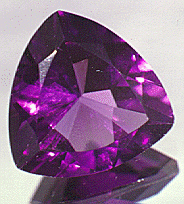

Ocurrance:
Worldwide
Appearance:
Violet, lilac or mauve
quartz is called amethyst. Amethyst is sometimes heat treated to form citrine.
Amethyst crystals can form together with citrine crystals to form bi-colored
quartz called ametrine. Its Purple hues vary from very pale to dark with
the medium dark to dark tones considered the most desirable. The term "Siberian
Amethyst" is used to denote a strong Purple color with flashes of Red evident
under strong light. Most Amethysts are relatively free of inclusions, but
color zoning is frequently encountered. Color zoning is a result of reversal
in crystal growth process. Typically the zoning is not seen when the Amethyst
is mounted.
Something
Extra:
Leonardo Da Vinci wrote
that amethyst was able to dissipate evil thoughts and quicken the intelligence.
Because amethyst was thought
to encourage celibacy and symbolize piety, amethyst was very
important in the ornamentation
of Catholic and other churches in the Middle Ages. It was, in
particular, considered
to be the stone of bishops and they still often wear amethyst rings.
The Greek work "amethystos"
basically can be translated as "not drunken." Amethyst was
considered to be a strong
antidote against drunkenness, which is why wine goblets were often
carved from it! The gemstone
still symbolizes sobriety.
It is the best known member of the Quartz family was revered by the ancients for its mystical powers. New Age belief holds that Amethyst can protect against viruses, destroy body toxins, and alleviate stammering. Amethyst is considered one of the best Crystals for higher spiritual attainment. Its mystic energy helps ward off negative vibrations and increase positive feelings while aiding the believer in clarifying inner spiritual directions.